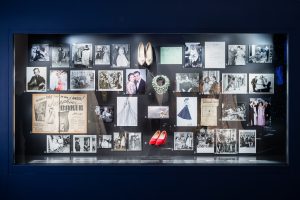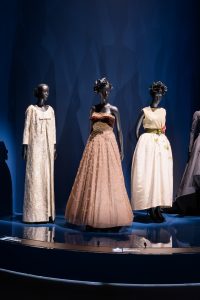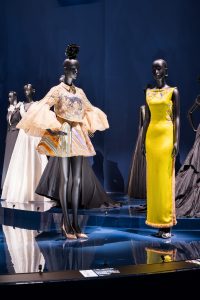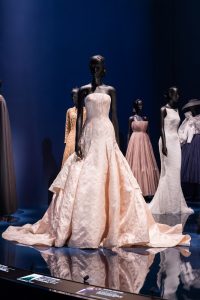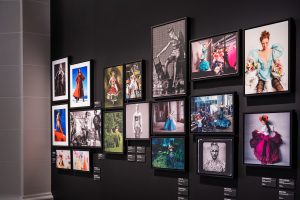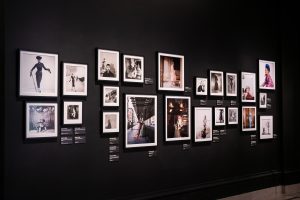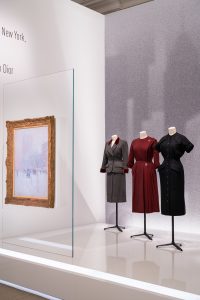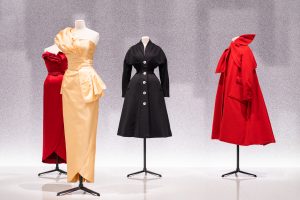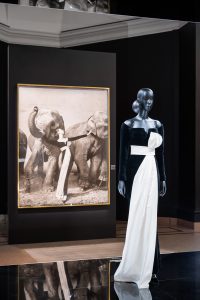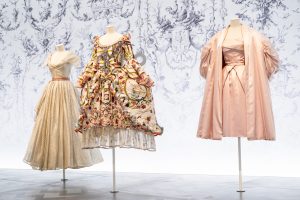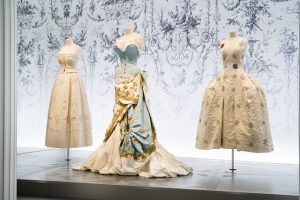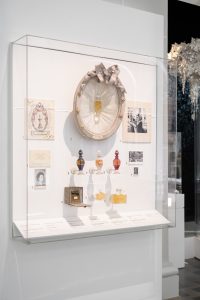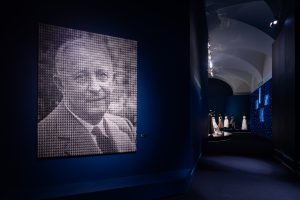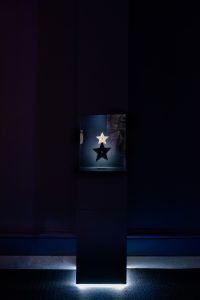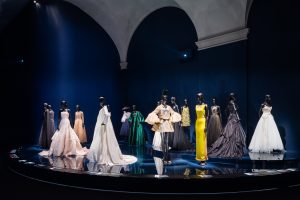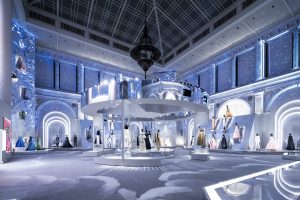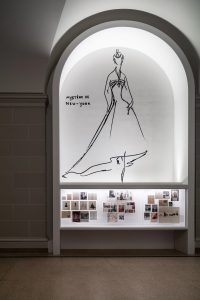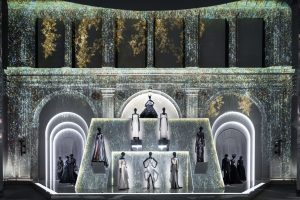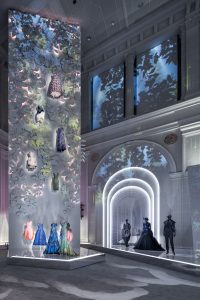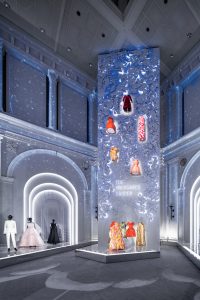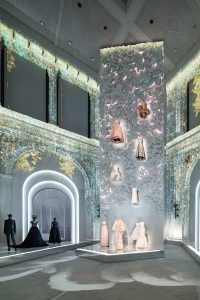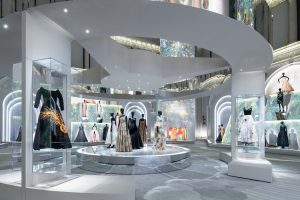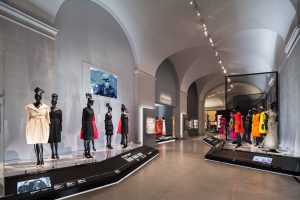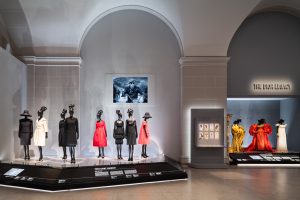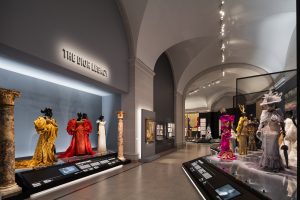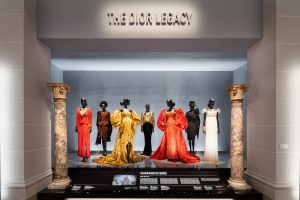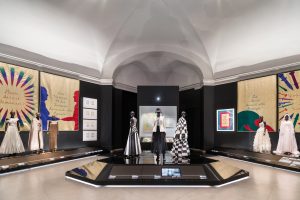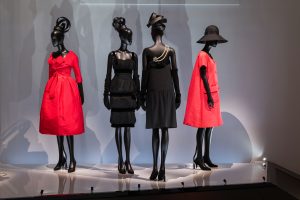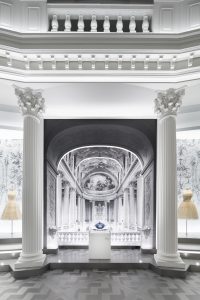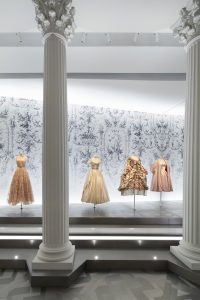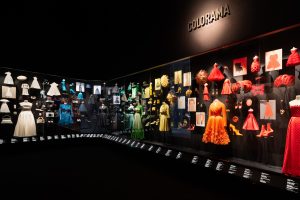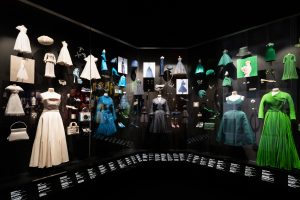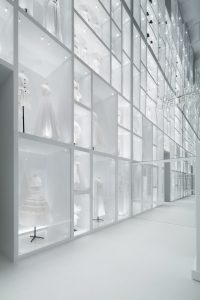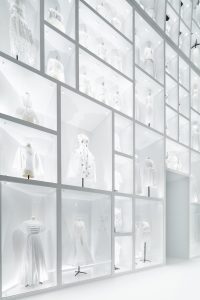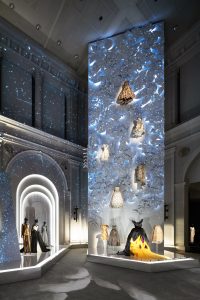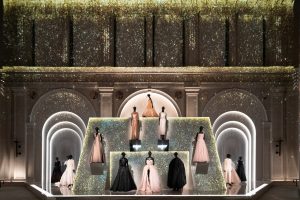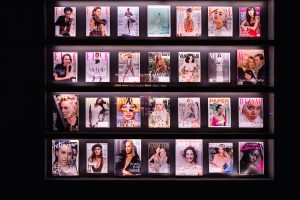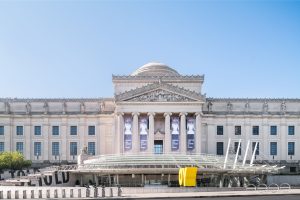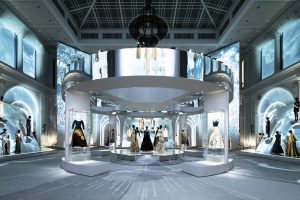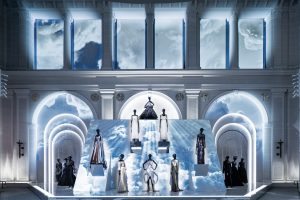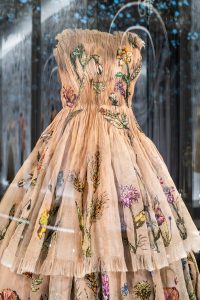From an early age, Christian Dior dreamed of becoming an artist. As such, the question must be asked: Is fashion design an art form? In some quarters, art is defined as a creative endeavor that moves the emotions. If so defined, Dior clearly lived his dream. Through the aesthetics of emotion, this dream-weaver created a fashion empire that greatly impacted our culture and sparked our aspirational desires.
Another notable hallmark of both art and fashion is their role in documenting and responding to the events of the day. Reflecting a time when the world was struggling to regain its footing after the ravages of World War II, Dior said, “We were just emerging from a poverty-stricken, parsimonious era, obsessed with ration books and clothes coupons. It was only natural that my creations should take the form of a reaction against this dearth of imagination.” A year after the war ended, the House of Dior was founded.
A short time later, the iconic French couturier presented a collection that offered visions of a new world. And on February 12, 1947, after the collection’s launch in Paris, Carmel Snow, the former Editor-in-Chief of the American edition of Harper’s Bazaar, coined the term, “The New Look.”
Through the exhibit “Christian Dior: Designer of Dreams,” which opened Sept. 10, The Brooklyn Museum transports visitors on an ethereal journey of discovery through the 70-plus-year history of the House of Dior. In a curatorial collaboration, Dior scholar Florence Müller, Avenir Foundation, Curator of Textile Art and Fashion at the Denver Art Museum; Matthew Yokobosky, Senior Curator of Fashion and Material Culture at the Brooklyn Museum; and Nathalie Criniere, the exhibition designer, mapped out a wondrous exploration, displaying more than 200 haute couture garments, photography and documentation, archival videos, sketches, perfume memorabilia and other period artifacts.
The show is a celebration not only of Dior’s genius and vision for “The New Look,” but also his entrée into New York and the American fashion scene. It also showcases the subsequent haute couture designs by six of his successors at the House of Dior: Yves Saint Laurent, Marc Bohan, Gianfranco Ferré, John Galliano, Raf Simons, and Maria Grazia Chiuri.
The architecture of the exhibition is stunning. When designing the space, Criniere said she would honor the architecture of the room. According to Yokobosky, “She indeed did . . . and in a spectacular way!” Ushering visitors through a rounded proscenium of galleries laid out in two concentric rings, the space documents the history, vision, legacy and inspirations that propelled the House of Dior to the forefront of French fashion.
Advertisement
The starting point of the experience is a sampling of images, editorials and press clippings documenting Dior’s early trips to New York, as well as a grouping of the first “New Look” designs, including Dior’s classic bar suit. Among the memorabilia is a brochure inviting fashion devotees and industry leaders to the Neiman Marcus department store’s Tenth Annual Fashion Show. The invitation also announces the presentation of the highly coveted award for Distinguished Service in the Field of Fashion to Christian Dior. Also so honored at that event were Salvatore Ferragamo (who came to America with Christian Dior on the Queen Elizabeth at the end of August 1947), Irene and Dolores del Rio.
This recognition prompted the designer to make his first visit to the United States and also sparked his love affair with and affinity for America. Emblazoned on one of the exhibition walls is a quote from Dior illustrating his feelings toward the American experience that reads, “The warmth of the American welcome is not a myth. And warmth and friendship are two things I cannot live without.”
The pièce de résistance of the masterfully curated presentation is the “Enchanted Garden.” Housed within the inner ring of the installation and under the museum’s expansive Beaux-Arts-styled atrium designed by McKim, Mead & White in 1913, and based on the cloister of Santa Maria della Pace, Rome, 1504, this dreamlike gallery offers an immersive look into Dior’s aesthetic sensibilities.
As visitors engage the historical chronology of the outer ring, they are invited to enter the Enchanted Garden at any point in their circular journey. Once enticed to the core of the exhibition, they are dazzled with fashions that intermingle with a dynamic architecture defined by colonnades, upward reaching verticals stretching to the ceiling, perspectives, vanishing points, and dimensions that draw the eye and the imagination in and through the space. Completing the experience are cascading points of light and exquisite projections of clouds and birds floating dreamily across the edifice.
Dior was immediately drawn to all that New York had to offer, from its architecture, its charm and the stylistic attitude of the fashionable New York woman. Enjoying a close relationship with the city, he opened Christian Dior New York on Fifth Avenue in 1948. The Brooklyn Museum exhibition skillfully positions high-end, ready-to-wear designs from the New York salon alongside Dior’s haute couture creations from Paris. Quite evident is the stylistic consistency of the Dior aesthetic emanating from both sides of the Atlantic.
The master couturier was greatly influenced by the beauty of flowers, particularly the rose, as well as nature, mythology, and both classical and contemporary art. In support of the fashions displayed in the show, the curators integrated artwork from the museum’s permanent collection.
Advertisement
“After readings and research, I’d send images and explanations of artworks in the Brooklyn Museum’s collection that I thought could be in dialogue with specific ideas or specific dresses. Florence and the Paris team would react . . . and vice-versa. It was a real dialogue,” says Yokobosky. “In some cases, for example, during the 1950s section, I wanted to feature artworks of the same period. Dior is quoted as saying that he could always design in black, so it was natural to show an abstract ‘black’ painting by Ad Reinhardt, and Louise Nevelson’s large black sculptural masterwork ‘First Personage’ alongside Dior’s dresses, creating a tableau of contemporaneous artists who were drawn to similar concepts, in the same era.”
Other notable artwork juxtaposed to further communicate the nuances of the designer’s vision include a 1900 Childe Hassam, a 1912 portrait by Giovanni Boldini, as well as “The Egyptian Dancers” by Anne Estelle Rice. A highlighted presentation of Richard Avedon’s iconic photograph “Dovima with elephants,” celebrates the first dress that a young Yves Saint Laurent designed for the House of Dior.
By providing a tactile experience and allowing visitors to fully appreciate the textures, embroideries, embellishments and masterful construction of every garment, the exhibition opens a window into the designer’s atelier where his visions were brought to life though sketches, engravings and copious toiles (test garments). Specialist seamstresses working under the supervision of the premier and second seamstress, often worked hundreds of hours to perfect a single design concept.
The Colorama Gallery is an artful demonstration of the full spectrum of the House of Dior’s tonal sensibilities ranging from bold hues to softer, more luminous color schemes. The color range is displayed through the use of accessories, dresses and drawings from 1947 to 2021. Another gallery of particular note is dedicated to the iconic American fashion photographers whose dynamic images played an important role in projecting the Dior image around the world. Photographs on display represent eight decades of work from Richard Avedon, Tyler Mitchell, Lillian Bassman Louise Dahl-Wolfe, Horst P. Horst, William Klein, David LaChapelle, Annie Leibovitz, Gordon Parks, Irving Penn, Herb Ritts and Cass Bird
After the grand success at the Musée des Arts Décoratifs in Paris – and then traveling the world with stops in London, Shanghai and Chengdu – “Christian Dior: Designer of Dreams” dazzles New York with this dynamic showing. It seems only appropriate that the legacy of the mid-century design icon who so loved New York should be celebrated in one of the city’s most revered cultural institutions. “The New Look” has come home.
Photography: Courtesy of The Brooklyn Museum


 Photo Gallery3 days ago
Photo Gallery3 days ago
 Headlines1 week ago
Headlines1 week ago
 Sector Spotlight2 weeks ago
Sector Spotlight2 weeks ago
 Headlines1 week ago
Headlines1 week ago
 Headlines4 days ago
Headlines4 days ago
 Headlines2 weeks ago
Headlines2 weeks ago
 Designer Dozen1 week ago
Designer Dozen1 week ago
 Headlines2 days ago
Headlines2 days ago
